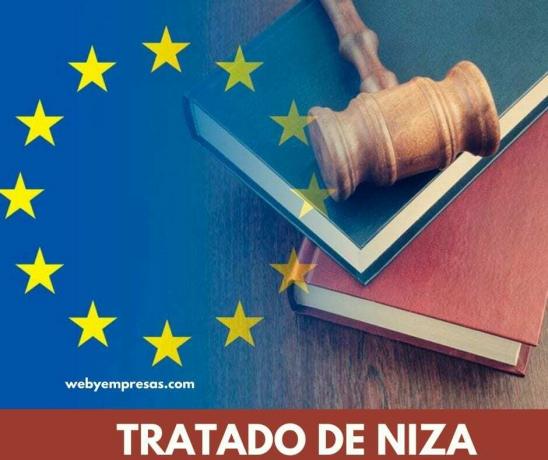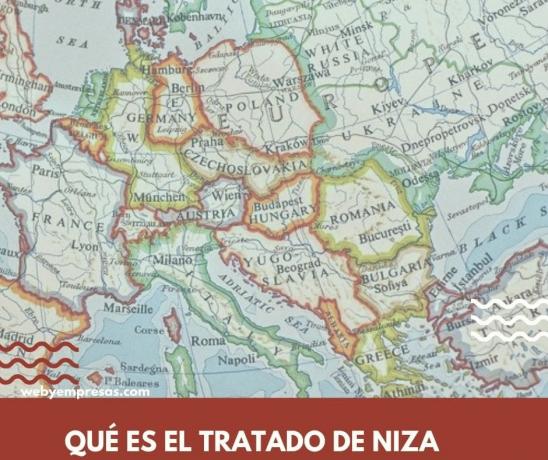The intergovernmental conference that began in February 2000 concludes in December of the same year, with the signing of the Nice Treaty, where an agreement was reached within the Nice European Council, said document and its text were published in March 2001, in the Official Journal of the European Community.
This treaty represents a step towards the objective of unifying Europe, modifies any existing treaty and will enter into force after being ratified by each of the member states, either by referendum or vote of parliaments nationals.
Advertisements
In this article you will find:
What is the Nice Treaty?

It is the treaty that changes the existing Constitutive Pacts of the European Communities, said treaty is has been in force since 2003 in the search to face new challenges presented by the extension.
Advertisements
What is the fundamental objective
The fundamental objective of the Treaty of Nice sought to adapt the functioning of the institutions involved in order to accommodate new member states, as a vital step to include the countries of Central, Eastern, Baltic and Mediterranean Europe in the unification European.
The negotiationIt was not simple, a conflict between the members was the definition of the voting mechanism, the second problem faced was the reduction in the number of commissioners, with the possibility that some members (the smallest) would be left without a commissioner permanent.
Advertisements
Basis of the Nice treaty and its objectives
Pursuant to Declaration No. 23 of said treaty, the European Council decides to create a convention to bring together stakeholders in the debate about the future of the European Union.
This consensus of member countries had the objective of preparing the next IGC in a transparent manner, addressing the following challenges related to the future and development of the Union:
Advertisements
- Better distribution of the competitions.
- Instrument simplification.
- Greater degree of transparency, democracy and efficiency.
- Preparation of the Constitution for European citizens.
Organization of the convention
It was composed of:
- The president (Valéry Giscard d’Estaing).
- 2 vice-presidents (Guiliano Amato and Jean-Luc Dehaene).
- 15 different representatives of Heads of State or Government of the member countries.
- 30 deputies of National Parliaments.
- 16 deputies of the European Parliament.
- 2 representatives of the European Commission.
The countries that were candidates for accession also participated in the discussions, their conditions were the same, but they did not have the possibility of preventing possible consensus among the members.
Advertisements
The praesidium included in addition to the president and vice-presidents, nine members of the convention and a representative designated by the candidates for accession. These had as mission to give impulse to the meetings of the convention and to provide a suitable work table.
In total, the convention had 105 members who were pursuing the growth of the European Union.
Notable changes to the Nice treaty

Some of the most notable changes that were introduced with the Nice treaty are:
- The new composition of the European Parliament was firmly established at 732 seats, supplanting the 626 that previously constituted it, Germany would have 99 deputies, the other large countries 72 and Spain and Poland 50.
- Greater measures were established for cases of violation by a member state of democratic agreements and principles and, in turn, of fundamental rights.
- They implemented measures prior to the sanctions established by the Amsterdam Treaty and, on the other hand, jurisdictional control of the Court of Justice and security was instituted.
- After 2005, countries like Germany, the United Kingdom, France, Italy and Spain that had two commissioners, would be left with only one.
- It was also agreed that when the European Union reaches 27 members, the number of commissioners must be decided by unanimous vote, which must be less than 27.
- The ECSC (European Coal and Steel Community) was eliminated and all its powers were transferred to the European Community.
Likewise, an egalitarian system of rotation must be designed, so that the composition of said Commission is able to reflect the demographic weight of the members.
- The powers assigned to the President of the Commission were strengthened. Said president will also be appointed according to the qualified majority, but not unanimously as had been done to date. This appointment must then be submitted to the European Parliament for approval.
- The qualified majority for the decision-making of the Council was extended in greater number of In spite of this the decision unanimously, it would remain the rule in more sensitive cases, such as social security, taxation, asylum and immigration.
- Certain restrictions will be presented, with which the possibility is presented for some countries to go more hastily in integration-related purposes, which received the name of Europe to different speeds.
To conclude, it is necessary to emphasize the fact that the Nice Treaty predicts a group of institutional reforms indispensable for the exercise of the enlarged Europe. The new measures were intended to adapt the three largest institutions of the European Union to the advent of 10 new members by 2004.


